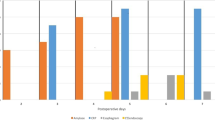Summary
Low pH (<7.1) and pO2 (<6.5 kPa) and high pCO2 (>8 kPa) of peritoneal fluid have been previously associated with the presence of intra-abdominal infection. These parameters were monitored in drainage fluid following emergency laparotomy in 40 patients operated on for intra-abdominal infections and also in 15 patients who underwent laparotomy for another reason than infection. Significant differences were observed beginning on the fourth postoperative day between the 48 patients who improved or were cured and the seven patients in whom therapy failed due to anastomotic breakdown or abscess formation. Anastomotic leaks or abscesses were radiologically confirmed. In five of the seven failures, complications were first detected by analysis of pH, pO2 and pCO2 before clinical symptoms became evident. Specificity for each of these parameters in drainage fluid samples obtained after the second postoperative day was >94%. Assessment of the three parameters allowed for simple, cost-effective, rapid and early detection of infectious complications following abdominal surgery.
Zusammenfassung
Tiefe Werte für pH (<7,1) und pO2 (<6,5 kPa) sowie hohe Werte für pCO2 (>8 kPa) in Peritonealflüssigkeit haben sich als charakteristische Parameter einer bakteriellen Infektion erwiesen. Diese drei Parameter wurden in Drainageflüssigkeiten gemessen, die von 40 Patienten nach notfallmäßiger Laparotomie infolge intraabdominaler Infektion gesammelt wurden. Zum Vergleich wurden auch Drainageflüssigkeiten von 15 Patienten asserviert, die aus anderen Gründen laparotomiert wurden. Vom vierten postoperativen Tag an wurden signifikante Differenzen festgestellt zwischen der Gruppe der 48 Patienten, die geheilt oder gebessert und der Gruppe jener sieben Patienten, deren Therapie wegen Anastomosenleck oder Abszeßbildung als Mißerfolg gewertet wurde. Anastomosenlecks and Abszeßbildungen wurden jeweils radiologisch bestätigt. Bei fünf der sieben Patienten, deren Therapie als Mißerfolg klassifiziert wurde, konnte die Komplikation auf Grund der Analyse von pH, pO2 und pCO2 in Drainagesekreten vermutet werden, bevor klinische Symptome manifest wurden. Die Spezifität aller drei Parameter, die in Drainageflüssigkeiten nach dem zweiten postoperativen Tag gemessen wurden, lag über 94%. Die Messung der drei Parameter erlaubt eine einfache, rasche, kostengünstige und frühe Erkennung infektiöser Komplikationen nach Laparotomien.
Similar content being viewed by others
References
Stassen, W. N., McCullough, A. J., Bacon, B. R., Gutnik, S. H., Wadiwala, J. M., McLaren, C., Kalhan, S. C., Tavill, A. S. Immediate diagnostic criteria for bacterial infection of ascitic fluid. Gastroenterology 90 (1986) 1247–1254.
Simmen, H. P., Blaser, J. Analysis of pH and pO2 in abscesses, peritoneal fluid and drainage fluid in the presence and absence of bacterial infection during and following abdominal surgery. Am. J. Surg. 166 (1993) 24–27.
Simmen, H. P., Battaglia, H., Kossmann, T., Blaser, J. Effect of peritoneal fluid pH on outcome of aminoglycoside treatment of intraabdominal infections. World J. Surg. 17 (1993) 393–397.
Light, R. W. Parapneumonic effusions and empyema. Clin. Chest Med. 6 (1985) 55–62.
Attali, P., Turner, K., Pelletier, G., Ink, O., Etienne, J. P. pH of ascitic fluid: diagnostic and prognostic value in cirrhotic and noncirrhotic patients. Gastroenterology 90 (1986) 1255–1260.
Potts, D. E., Levin, C. D., Sahn, S. A. Pleural fluid pH in parapneumonic effusions. Chest 70 (1976) 328–331.
Runyon, B. A., Antillon, M. R. Ascitic fluid pH and lactate: insensitive and nonspecific tests in detecting ascitic fluid infection. Hepatology 13 (1991) 929–935.
Author information
Authors and Affiliations
Rights and permissions
About this article
Cite this article
Simmen, H.P., Battaglia, H., Giovanoli, P. et al. Analysis of pH, pO2 and pCO2 in drainage fluid allows for rapid detection of infectious complications during the follow-up period after abdominal surgery. Infection 22, 386–389 (1994). https://doi.org/10.1007/BF01715494
Received:
Accepted:
Issue Date:
DOI: https://doi.org/10.1007/BF01715494




